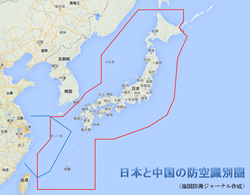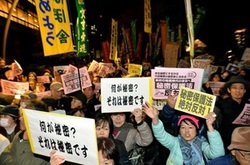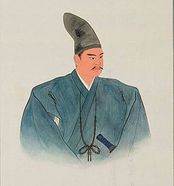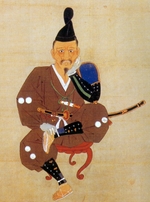 Source: blogs.yahoo.co.jp
Source: blogs.yahoo.co.jp As this excellent analysis by CSIS shows, the US and Japan very quickly dismissed the Chinese announcement, stating that their respective forces would not abide by the Chinese demands for identification. As if to prove this point, on Tuesday afternoon the US had two B-52 bomber aircraft fly from Guam and enter the disputed airspace. Despite the fact that B-52s show up very easily on radar (and were not accompanied by any fighter aircraft), Beijing did not respond, and the aircraft left the airspace uncontested. Clearly the US decided that it would test the veracity of Beijing’s claim to an ADIZ and how willing it is to enforce that claim. As to why China did not respond, there could be a myriad of reasons, not least of which may be the fact that China did not count on the US reacting so soon to its announcement. As China appears to have had Japan in mind when it made the announcement, the appearance of US assets in the ADIZ may have given China pause for thought, and a decision was made not to challenge the B-52s (as this may have led to another Hainan Island-style incident).
As Sydney Freedberg pointed out on breakingdefence.com, this move by China appears to have primarily been the work of the PLA, which has been particularly vocal in its promotion of China’s sovereignty rights. Indeed, it was the Chinese Ministry of Defence that announced the creation of the ADIZ and not the Ministry of Foreign Affairs, which has been fairly reticent on the issue and has only released to official notices concerning the ADIZ.
The role of the PLA in aggressively pursuing territorial rights for China has been a subject on this blog in the past, and may have been one reason why China was initially slow in its reaction to Typhoon Haiyan and the offer of assistance to the Philippines. This reluctance was definitely noticed by other Southeast Asian nations, who would regard the unilateral move by China on the weekend with a similar, if not the same degree of concern that Japan has. After all, if China is willing to do this in the East China Sea, it may do the same in the South China Sea (although given China’s attempts to forge better relations with ASEAN, this may only be a measure aimed at Japan and to a lesser extent South Korea).
Hugh White, writing in the SMH on Tuesday, said that this move by China was calculated to test US resolve and its willingness to defend its alliance with Japan. China, according to White, knew exactly what it was doing when it made the announcement, judging that it would serve as a test of whether the US still wished to claim primacy over Asia. Given the degree of opaqueness regarding decision making within the Chinese Politburo, this is at best an educated guess. What the move does suggest is that diplomacy wasn’t a factor in the decision to impose the ADIZ, for in doing so China managed to upset South Korea, a country which had, until recently, been willing to discuss trade and defence with. Moreover, next week US Vice President Joe Biden will be paying a visit to Northeast Asia, thereby giving him ample time to reassure Japan and South Korea of the US commitment to both countries, and send a message to China that acting unilaterally only damages China’s standing in the region.
China must have been aware of Biden’s impending visit, so the timing of the announcement on the ADIZ was either; a) deliberately made to test US resolve before Biden’s visit or b) was made without Biden’s visit being taken into account. The very fact that the announcement came without any preliminary warnings meant that the decision was taken within the Politburo without reference to any outside agencies, particularly the Ministry of Foreign Affairs. The announcement did nothing to further China’s diplomatic standing and ramped up the possibility of armed conflict, a situation that only the PLA would benefit from (by being seen as defending Chinese sovereign interests).
Hence now China has a number of choices to make – it can either enforce its ADIZ, redefine its ADIZ, or remove it altogether and return to the status quo. The last option is not realistic, given that any sign of backing down by China over the Senkaku Islands would be interpreted domestically as weakness against Japan. Perhaps China will see fit to impose an ADIZ but not patrol it, which would defeat the purpose of having an ADIZ but would at least provide the PLA with a piece of propaganda demonstrating its resolve on sovereignty issues.
So how should Japan react to this development? The Abe government has already made clear that it does not intend to adhere to the ADIZ requirements in any form, and indeed had Japanese domestic and international airlines announce that they too would not follow any procedures imposed by China over the disputed area. In order to gain leverage from the situation, Japan would be advised to seek cooperation from other regional members in urging China to suspend its enforcement of the ADIZ for the foreseeable future, until clear guidelines and protocols have been agreed upon (which they won’t, but at least it enables both sides to ‘save face’ without appearing to concede ground). If China does not agree to this, Japan should use this as a pretext to condemn China’s move as destabilising the region, and the UN would be an appropriate forum for this.
PM Abe could also start another round of regional visits, zigzagging from Russia to Southeast Asia to demonstrate Japan’s commitment to the rule of law as defined by international organisations and contrast this to China’s own preference for unilateral decisions. This could then promote further cooperation between countries to ensure that China cannot enforce ADIZ without severely disrupting regional air traffic, air traffic that China depends upon for its economy.
What China has done is give Japan another example of just how recklessly China makes decisions and how this has a negative impact on regional security. It will drive other regional states to forge closer ties with one another so that their sovereignty is not threatened by an expansionist China. China will be seen as unpredictable in its decision-making, imposing regulations without recourse to diplomatic channels and therefore unsuitable as a strategic partner. If this is what the PLA had in mind by making the announcement on Saturday, then it appears to have inflicted another blow on China’s diplomatic relations. This can only lead to positive developments in Japan’s diplomatic initiatives.




 RSS Feed
RSS Feed